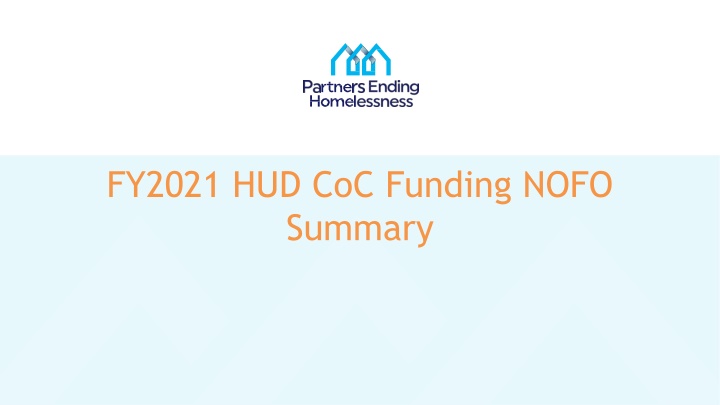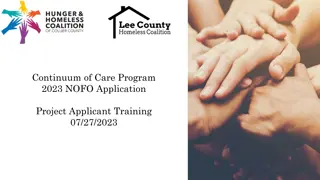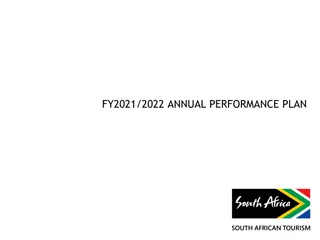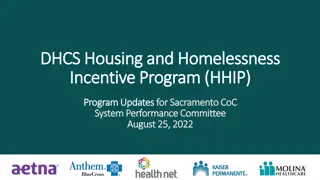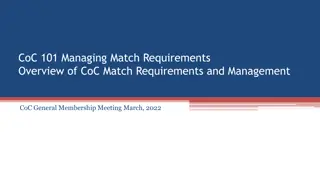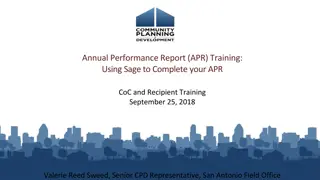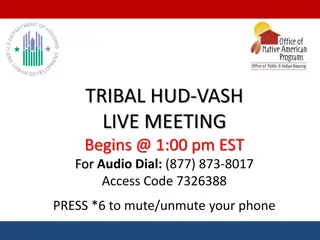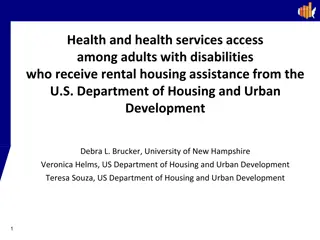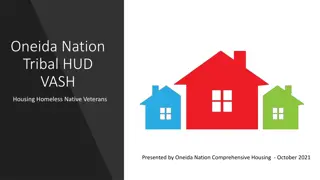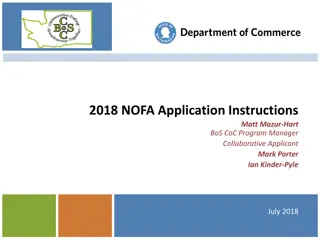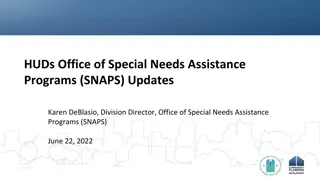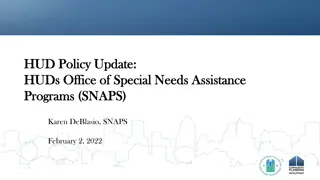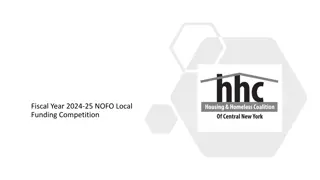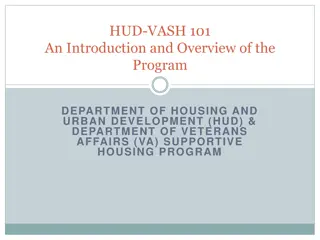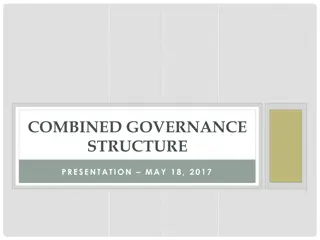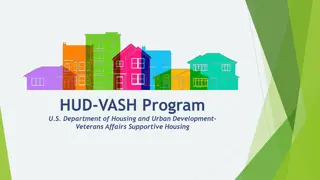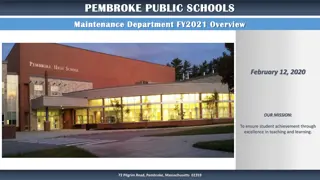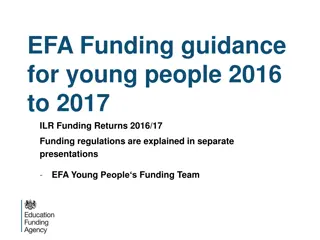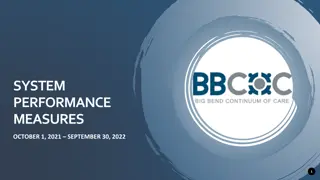FY2021 HUD CoC Funding Overview
Providing a detailed summary of the FY2021 HUD CoC Funding Notice of Funding Opportunity (NOFO), including available funding nationally and locally, HUD priorities, major changes in funding criteria and system performance evaluation, and upcoming workshops for new project applicants.
Download Presentation

Please find below an Image/Link to download the presentation.
The content on the website is provided AS IS for your information and personal use only. It may not be sold, licensed, or shared on other websites without obtaining consent from the author.If you encounter any issues during the download, it is possible that the publisher has removed the file from their server.
You are allowed to download the files provided on this website for personal or commercial use, subject to the condition that they are used lawfully. All files are the property of their respective owners.
The content on the website is provided AS IS for your information and personal use only. It may not be sold, licensed, or shared on other websites without obtaining consent from the author.
E N D
Presentation Transcript
FY2021 HUD CoC Funding NOFO Summary
Funding Available Total Funding Available Nationally: CoC Program Funding - $2.65 billion DV Bonus Project Funding - $102,000,000 YHDP Non-competitive YHDP renewal and replacement grants (N/A) Local Project Funding: $12,8250,456 Annual Renewal Demand (ARD) $385,514 CoC Planning Grant (3% of ARD) $642,523 CoC Bonus Projects (5% of ARD) $1,377,393 DV Bonus Funding letsendhomelessness.org
HUD Priorities End homelessness for all Use Housing First approach Decrease numbers of unsheltered homeless Increase system performance Partnering with Housing (focus on PHAs) and Healthcare Organizations Racial Equity Inclusion of people with lived experience in local planning process letsendhomelessness.org
Major Changes Tier 1 includes 100% of Annual Renewal Demand (ARD) CoCs that create projects that coordinate with housing providers and healthcare organizations will receive bonus points Increased points for collaboration with Public Housing Authority(s) (PHA) Increased points for Racial Equity activities Increased points for inclusion of persons with lived experience Points for how the CoC addresses challenges due COVID-19 Points for CoC coordination with ESG-CV funding Only the sheltered PIT count will be scored for this fiscal year letsendhomelessness.org
Major Changes System Performance CoCs should review all projects eligible for renewal in FY2021 to determine their effectiveness in serving people experiencing homelessness, including cost- effectiveness. CoCs should also look for opportunities to implement continuous quality improvement and other process improvement strategies. HUD recognizes that CoC performance and data quality may have been affected by COVID-19 compared to previous CoC NOFOs, and has reduced the points available for rating factors related to system performance. However, HUD plans to significantly increase the points for performance rating factors in the FY 2022 and subsequent CoC NOFOs. letsendhomelessness.org
FY2021 CoC Program Funding Partners Ending Homelessness New Project Applicant Workshop
Introduction Partners Ending Homelessness, the lead agency for the Continuum of Care (CoC), representing the City of Rochester, County of Monroe, and Towns of Greece and Irondequoit (NY- 500), will submit a CoC Program Consolidated Application for funding to the U.S. Department of Housing and Urban Development (HUD) in the upcoming FY 2021 Continuum of Care Homeless Assistance Program Competition. This presentation describes the New Project Application submission and review process. letsendhomelessness.org
Application Review The Ranking and Review Committee will evaluate the applications based on the Scoring Rubric provided. The following policies were approved: 1. The process shall be transparent and impartial 2. The process includes an Appeal Process 3. New applications will be scored using the 2021 New application Scoring Rubric 4. New projects created with reallocation funding will be placed at the bottom of Tier 1 5. New projects created with bonus funding will be ranked against each other and placed in Tier 2 in order by score letsendhomelessness.org
Eligible Organizations Non-profits, states, local government, and instrumentalities of local government Individuals and for-profits are not permitted to apply for grants or be sub-recipients of grants New Program funding is derived from Reallocation And/or bonus funding letsendhomelessness.org
HUD CoC Housing Components Permanent Supportive Housing (PSH) Rapid Re-Housing (RRH) Transitional Housing to Rapid Re-Housing (TH-RRH) letsendhomelessness.org
Eligible Components: Permanent Housing 1. Permanent Housing : Community-based housing, the purpose of which is to provide housing without a designated length of stay. It includes: a. Permanent Supportive Housing (PSH) Programs formerly known as S+C and some SHP Permanent Housing Programs Provides long-term housing assistance to homeless individuals and families in which one adult or child has a disability I. II. III. PSH Programs PRIORITIZE Chronically homeless individuals and families letsendhomelessness.org
Eligible Components: Permanent Housing b. Rapid Re-Housing (RRH) Programs formerly known as scattered-site Transitional Housing and some short-term SHP Permanent Housing Programs Designed to help homeless individuals and families move as quickly as possible into permanent housing and achieve stability in that housing. I. II. III. Provides short and/or medium-term assistance rental assistance and case management (up to 24 months) IV. The program participants KEEP the housing/unit when assistance ends. Client does not need to have a disability to enter project. V. letsendhomelessness.org
Eligible Components: Eligible Components: Permanent Housing Transitional Housing (TH) to Rapid Rehousing (PH-RRH) A Joint TH and PH-RRH Component project is a new project type in the established in 2017 which includes two existing program components TH and PH-RRH in a single project to serve individuals and families experiencing homelessness. It could provide short- or medium-term tenant-based rental assistance on behalf of program participants in the rapid rehousing portion of the project. Supportive services must be provided for the entire project. The TH units/beds will be supported by the transitional housing component and the tenant-based rental assistance and services provided through the PH-RRH component. The program can serve participants up to 24 months or as long as the program dictates. A program participant may only need the temporary stay in transitional housing unit, or just the rapid re-housing assistance, but the recipient or subrecipient must be able to make available the financial assistance and supportive services that traditionally comes with rapid re-housing assistance to that program participant if needed. Likewise, the rapid re-housing can be accessed without entering the TH program. letsendhomelessness.org
Homeless Definitions Category 1- Literally Homeless An individual or family who lacks a fixed, regular, and adequate nighttime residence; An individual or family with a primary nighttime residence that is a public or private place not designed for or ordinarily used as a regular sleeping accommodation for human beings; An individual or family living in a supervised publicly or privately operated shelter designated to provide temporary living arrangements; letsendhomelessness.org
Homeless Definitions Category 2 Imminent Risk of Homelessness Residence will be lost within 14 days of the date of application for homeless assistance No subsequent residence has been identified The individual or family lacks the resources or support networks needed to obtain permanent housing letsendhomelessness.org
Homeless Definitions Category 4-Fleeing Domestic Violence Individuals and families who are fleeing, or are attempting to flee, domestic violence, dating violence, sexual assault, stalking, or other dangerous or life-threatening conditions related to violence, who: Have no identified subsequent residence; AND Lack the resources and support networks needed to obtain other permanent housing. letsendhomelessness.org
Housing Component Eligibility PSH Category 1 TH/RRH Category 1, 2 (for TH only) and 4 RRH Category 1, 4 letsendhomelessness.org
Housing First in Permanent Supportive Housing Housing First is a best practice model to quickly and successfully connect individuals and families experiencing homelessness to permanent housing without preconditions and barriers to entry, such as sobriety, treatment or service participation requirements. Supportive services are offered to maximize housing stability and prevent returns to homelessness as opposed to addressing predetermined treatment goals prior to permanent housing entry. Housing First emerged as an alternative to the linear approach in which people experiencing homelessness were required to first participate in and graduate from short-term residential and treatment programs before obtaining permanent housing. In the linear approach, permanent housing was offered only after a person experiencing homelessness could demonstrate that they were ready for housing. letsendhomelessness.org
Housing First in Permanent Supportive Housing Few to no programmatic prerequisites to permanent housing entry Low barrier admission policies Rapid and streamlined entry into housing Supportive services are voluntary, but can and should be used to persistently engage tenants to ensure housing stability Tenants have full rights, responsibilities, and legal protections Practices and policies to prevent lease violations and evictions letsendhomelessness.org
Chronically Homeless vs DedicatedPLUS PSH All new PSH projects must either be (1) 100 dedicated to chronic homelessness or (2) DedicatedPLUS. Chronically Homeless Beds that are dedicated to chronically homeless individuals and families are those beds explicitly dedicated for use by chronically homeless individuals and families within a CoC. Another chronically homeless participant must fill the bed unless no chronically homeless persons are located within the CoC's geographic area. This concept only applies to permanent supportive housing (PSH) projects. If a project comprises 100 percent dedicated beds, it is called for chronically homeless individuals and families. letsendhomelessness.org
Chronically Homeless vs DedicatedPLUS PSH DedicatedPLUS A DedicatedPLUS project is a permanent supportive housing (PH-PSH) project where the entire project will serve individuals and families that meet one of the following criteria at project entry Experiencing chronic homelessness as defined in 24 CFR 578.3; Residing in a transitional housing Residing in a place not meant for human habitation, emergency shelter, or safe haven; but the individuals or families experiencing chronic homelessness as defined at 24 CFR 578.3 had been admitted and enrolled in a permanent housing project within the last year and were unable to maintain a housing placement; Residing in transitional housing funded by a Joint transitional housing (TH) and rapid re-housing (PH-RRH) Residing and has resided in a place not meant for human habitation, a safe haven, or emergency shelter for at least 12 months in the last three years, but has not done so on four separate occasions; or The DedicatedPLUS concept provides more flexibility, particularly those that have already dedicated 100 percent of the PSH resources to chronic homelessness. DedicatedPLUS eligibility to serve persons with long histories of homelessness and severe service needs who would not meet the definition of chronic homelessness at project entry. https://www.hudexchange.info/faqs/reporting-systems/e-snaps-homeless-assistance-application-and-grants-management-system/nofasnotices/fy-2017-nofa/can-you-explain-the- difference-between-beds-dedicated-to-chronically/ letsendhomelessness.org
Rent: Permanent Supportive Housing It is the expectation that PH program engage their participants to achieve housing stability which includes paying a portion of the rent Rent will be the highest of: 30 percent of the family s monthly adjusted income; 10 percent of the family s monthly gross income; or The portion of the family s welfare assistance, if any, that is designated for paying rent Income must be calculated according to 24 CFR 5.609 and 24 CFR 5.611(a) letsendhomelessness.org
New Project Funding Reallocation funding available is $516,480 Projects approved using reallocated funds will be placed at the bottom of Tier 1 CoC Bonus funding available is $642,523, calculated at 5% of ARD DV Bonus funding available is $1,377,393 Projects approved for bonus funds will be scored and placed in Tier 2 in ranked order. letsendhomelessness.org
Reallocation Funding The Reallocated funding is $516,480 dollars PSH project Supportive services dollars available 10% admin available 45 House holds (119 total people) 17 Individuals 28 Families letsendhomelessness.org
Eligible New Project Applications Permanent Supportive Housing (PSH) for Chronically Homeless Rapid Re-Housing (RRH) Transitional Housing-Rapid Re-Housing (TH-RRH) DV-RRH* HealthCare Partnership (PSH or RRH)* Housing Partnership (PSH or RRH)* *5-point bonus for new projects that are DV-RRH or partnering with healthcare or housing organizations to provide permanent supportive housing or rapid rehousing services letsendhomelessness.org
Eligible New Project Applications All new projects can request an 18-month grant term for the first year of operation. This is to allow for start up, new hiring, etc. Project will receive one year of funding that must be spread over the 18-month period If projects, choose the 18-month grant term they will be treated as a renewal project in the following fiscal year. letsendhomelessness.org
Expansion Project Applications An expansion grant must increase units, beds, services, or person served in an existing grant. Must be for activities and funding parameters allowed under reallocation, CoC Bonus or DV bonus projects. Must submit a renewal and an expansion grant application. If both renewal and expansion grant is awarded, one grant agreement will be executed. If renewal not awarded, expansion is not award. If renewal awareed ut not the expansion, the renewal grant continues as currently operated. letsendhomelessness.org
Consolidation Grant Applications Organization may consolidate 2-10 projects of the same component type Must submit renewal applications and a consolidated project application into Esnaps. letsendhomelessness.org
Transition Grant Applications A grant to fund a new project to transition an eligible renewal project being eliminated through reallocation from one program component to another new component over a one-year period. No more than 50% of the grant can be used for eligible activities of the original grant. All remaining funds must be used under the new component of the project. Eligible for renewal in future years for only the new component activities Must get approval from the CoC. letsendhomelessness.org
New Project Models Domestic Violence RRH Project Two years of DV-Bonus Project funding is available Eligible activities DV-RRH Comparable Database 100% of project participants must be fleeing DV *5-point bonus for new projects that are DV-RRH letsendhomelessness.org
New Project Models Healthcare Partnership PSH or RRH Provides MOU with Healthcare partners and states project will receive services from Healthcare organization for the duration of the project. Sources of health care resources include: 1. Direct contributions from a public or private health insurance provider to the project, and Provision of health care services by a private or public organization tailored to the program participants of the project. 2. Eligibility for the project must comply with HUD program and fair housing requirements. Eligibility criteria cannot be restricted by the eligibility requirements of the health care service provider. Healthcare services MUST be committed for the lifetime of the proposed project. * 5-point bonus for new projects with Healthcare Partnership letsendhomelessness.org
New Project Models Healthcare Partnership PSH or RRH Continued Projects must demonstrate through a written commitment from a health care organization that the value of assistance being provided is at least in the case of a substance abuse treatment or recovery provider, it will provide access to treatment or recovery services for all program participants who quality and choose those services; or an amount that is equivalent to 25 percent of the funding being requested for the project will be covered by the healthcare organization. Acceptable forms of commitment are formal written agreements and must include: 1. value of the commitment, and 2. dates the healthcare resources will be provided. In-kind resources must be valued at the local rates consistent with the amount paid for services not supported by grant funds. CoCs can receive less than full points for demonstrating commitments less than the threshold described above. letsendhomelessness.org
New Project Models Non-CoC Funded Housing Partnership The rental subsidy for these projects must be provided through other non-CoC sources of funding, i.e. private funding, state or local government, other federal funding that is not CoC or ESG Projects can be PSH or RRH Minimum requirements: for PSH projects, at least 25% of units must have non- CoC funding; for RRH projects, at least 25% of the participants must receive housing and services using non-CoC funding * 5-point bonus for new projects with Healthcare Partnership letsendhomelessness.org
Application Submission Timeline New Project Applications: To be reviewed and considered for funding, completed Applications, including all required documentation, must be submitted electronically by 12:00pm (Noon) on Friday, September 17, 2021. All components of an Application must be transmitted at the same time via email only to Charles Bollinger III at cbollinger@letsendhomelessness.org. Questions about the local Application process should be directed by email only to Charles Bollinger III at: cbollinger@letsendhomelessness.org . letsendhomelessness.org
Application Materials Application Materials Can be found on the www.letsendhomelessness.org website All materials can be downloaded directly from the website The CoC will not email out materials this year letsendhomelessness.org
New Project Application https://letsendhomelessness.org/about/funding/new-project- application-2021-8-30-21/ letsendhomelessness.org
Budget All projects must complete Budget Workbook Complete the worksheets that are appropriate for your project. Choose N/A box on top of each worksheet that you are not using Green cells are only places where numbers should be entered HMIS worksheet is only for dedicated HMIS project Complete Total Budget Worksheet last Fill in Project Administration up to 10% only. All other lines will be auto-filled as you complete the other worksheets New Projects MUST use FMR rents only. Please attach documentation of match and include detail on description of contribution Budget Points=8 letsendhomelessness.org
Match Minimum Match requirement is 25%. Applications cannot be reviewed if there is insufficient match. Match may be cash or in-kind. Cash match must be cash that comes through your organization s books and is used for eligible program expenses for the CoC funded project. In-kind match are materials or labor that is donated to the project. Must include the cash value for the service/goods/labor and how you arrived at the amount. In-kind match must be documented with an MOU and not a letter. Funds requested for leasing do not require a 25% match. letsendhomelessness.org
New Application Attachments Narrative attachments for the New Project Application should be included in one document and labeled as Application Attachments for ______________ The budget workbook is a separate attachment and named Budget for ___________________ letsendhomelessness.org
New Project Presentations Presentations will be scheduled for September 29, with October 1 as a back-up date if needed A presentation to the ranking and review committee will be required for all new projects. This presentation helps the reviewers better understand the new project and their plan on achieving community and HUD goals in the upcoming year. Reviewers can award plus or negative 5 points based on the presentation. If you want to present materials to the committee, please them emailed to cbollinger@letsendhomelessness.org no later than Noon on September 23rd . The first New Project application submitted can choose their time of presentation based on schedule that is set up letsendhomelessness.org
HUD References The 2021 CoC Program Notice of Funding Opportunity (NOFO) New Applicants must also comply with the rules, regulations, and guidance in 2021 HUD NOFO. https://www.hud.gov/sites/dfiles/SPM/documents/FY21_Continuum_of_Care_Competition.pdf CoC Program Interim Rule (24 CFR part 578) https://www.hudexchange.info/resources/documents/CoCProgramInterimRule_FormattedVersion.pdf Housing First Information https://www.hudexchange.info/resources/documents/Housing-First-Permanent-SupportiveHousing- Brief.pdf Rapid Re-Housing Information https://www.hudexchange.info/resources/documents/Rapid-Re-Housing-Brief.pdf https://www.hudexchange.info/resource/2889/rapid-rehousing-esg-vs-coc/ letsendhomelessness.org
Timeline of Important Dates August 24: August30: Local New Application Materials Available Local New Application Workshop via Zoom 1 pm- 2:30 pm August 31: Esnaps Training via Zoom 2:30 4pm September 17: New Project Applications Due by 12pm (Noon) September 29 & October 1: New Project Presentations October 27: Applicants Notified of Final Project Rankings and posted to PEH website 42 letsendhomelessness.org
Questions letsendhomelessness.org
